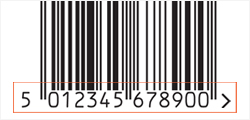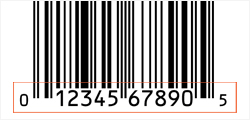Are you confused about GTINs, EANs and UPCs for use on Amazon, eBay or Google Shopping?
Online sellers now need to include a product identifier on their listings for trading on an online marketplace. These usually take the form of an EAN (European Article Number) or UPC (Universal Product Code) or, if the product doesn't need one, then some products can use a combination of the Brand and internal Manufacturer Part Number (MPN). This is a new requirement for online sellers – and it can be a tedious task for them to update all of their listings.
Uniquely identifying your products is important for helping your business’ supply chain to run smoothly. We think it’s important for you to understand the basics of why this is happening, so we’ve created these FAQs to help you understand what’s required, where you can get your GTINs to identify your products, how you can identify your products correctly and avoid any unnecessary risk to your eBay, Amazon or Google Shopping listings.
A barcode is the image you’ll recognise from most products that you see every day. It is the machine readable version of a Global Trade Item Number (GTIN) - the number that sits underneath the barcode - formed of black and white lines that allows lasers to read the number and automatically identify a product.
Global Trade Item Number (GTIN) – The name given to the number that uniquely identifies a product and is mostly commonly seen sitting underneath the black and white lines of a barcode. Is 12 digits in North America, but it’s usually 13 digits long in the rest of the world, or occasionally 8 digits (for very small products).

European Article Number (EAN) – The name given to the standard barcode image that represents the 13 digit GTIN on most products you buy in shops in the UK and globally, except for North America.

Universal Product Code (UPC) - The name given to the standard barcode image of a 12 digit GTIN that is commonly used in North America.
Global Location Numbers (GLNs) - The name given to a unique set of numbers that are used to recognise, and distinguish between, whole organisations or sub-locations within an organisation.
They can be used to identify a particular supplier, manufacturer, or hospital and their respective departments or wards, or even a specific shelf or a patient bay.
SSCC stands for Serial Shipping Container Code, and is a GS1 Identification Key that is used to identify a logistic unit such as containers, packages and pallets. The SSCC enables a logistics unit to be tracked individually to support order and delivery tracking and automated goods receiving.
A UPC is usually a 12-digit barcode used in North America to identify most products. The rest of the world uses 13-digit EAN barcodes to identify products. However, both types of numbers and barcodes are part of the GS1 System of international standards, so both are accepted globally.
No. A UPC barcode and 12 digit GTIN does the same job as an EAN barcode and 13 digit GTIN. The UPC originated in the US, but is part of the global GS1 System. So if you license UPCs from a GS1 organisation, you’ll have no problems using them globally. When a 13 digit number is required you can add a zero to the front of your 12 digit GTIN.
A product identifier is simply a number that allows you to uniquely identify your product.
The GS1 System of product identification ensures that the number you have given your product is unique. Retailers have been using GS1 product identifiers – GTINs - to manage their inventories for over 40 years.
Today, with 100s of millions of products now listed online on websites and marketplaces this is more vital than ever. Marketplaces use product identifiers to manage their product catalogues, so if your product is mis-numbered and has the same identifier as another product it causes a data conflict.
If you’re trading online with a marketplace such as Amazon, eBay or Google Shopping, they all now require you to input a product identifier when you list your product.
However, if your self-fulfilling by selling direct to consumer (D2C), with no trading partners, or you sell handmade/one off products then it is unlikely you will need a product identifier.
As marketplaces develop their websites, they need more information about what’s listed in their catalogues. As with traditional retail, knowing what’s available to buy in their catalogues is essential to keeping shoppers happy – and buying your products.
Product identifiers will help you to grow your business. They’re a great way to improve traffic to your listings. This is because search engines such as Google and Bing are also using product identifiers as a way of tying together the information about your product in a structured way – this makes it easier for them to return your listings for relevant search queries.
Uniquely identified products also allow the marketplaces to better understand what’s in their catalogue. Marketplaces such as Amazon and eBay are using product identifiers to structure product data on their websites so that they can improve a shopper’s experience. Product identifiers are used to drive features such as product reviews and to create smarter offers for shoppers.
It doesn’t matter. If you’re a GS1 UK member you’ll get a company prefix that enables you to create 13 digit identifiers – GTINs - that are used in EAN barcodes. But 12 digit GTINs and 13 digit GTINs, which are represented by UPC and EAN barcodes, are both part of the global GS1 System so both will be suitable for your products.
Amazon required GTINs for the entire fashion category – clothing, footwear and accessories.
Google Shopping requires GTINs for shoes, sunglasses, handbags and watches. And in all categories Google states that “Whenever GTINs are available, we strongly recommend providing them in the 'GTIN' attribute.”
For eBay, GTINs are required for all single and multivariate listings for new, relisted, revised and Good ‘Til Cancelled listings of new and manufacturer-refurbished items. There are some exceptions for the clothing, footwear and accessories category – these can be found here.
Yes, if it’s from a GS1 organisation. Amazon accept GS1 GTINs in all of their forms, so if you have a GTIN-13 (or EAN number) or GTIN-12 (or UPC number), when you’re listing a new product you’ll most likely be asked to provide one. There are some exceptions and exemptions for some products, these can be found here.
GS1 is the not-for-profit organisation that administers and maintains the GS1 System of supply chain standards globally. These standards include product identifiers such as GTINs, as well as EAN and UPC barcode specifications. We work with over 2 million members worldwide to ensure our standards support industries as they develop and grow.
GS1 GTINs, EAN and UPC barcodes are used in the UK and all over the world. Over 150 countries use the GS1 System – with over 6 billion GS1 barcodes scanned every day!
When you join a GS1 organisation you’re allocated a unique company prefix that allows you to generate your GTINs. This prefix is licensed to you on an annual basis. Similar to your TV licence, as long as you need to identify your products you need to renew your licence.
As your company prefix is licensed from GS1, this means there is an annual licence fee for your membership.
With a GS1 membership we leave the best person in charge to manage your product data – you. So we won’t send you each identifier individually. You’ll get a unique company prefix, and from this you can start assign anything from 10 to 100,000 GTINs depending on the number of product variants you have.
You can manage all your numbers online using our secure online service, My Numberbank. You’ll find this in the member’s area of our website.
You can register at www.gs1uk.org and you’ll receive your company prefix in a matter of minutes – which means you can start assigning GTINs immediately.
Yes, all GS1 members are licensed a unique company prefix which enables them to give each of their products a unique GTIN – so as long as you assign the numbers correctly you won’t have any problems.
Yes, the GS1 system is used in over 150 countries worldwide, so you do not need a different number for a different country. One product = one number, regardless of the channel or country.
There are millions of trading partners all over the globe using our standards for product identification and barcodes.
No, it can do a lot more for you than that. You can use the number to put a barcode on the product, which gives you the benefit of not having to change the barcode for each channel you sell through.
Using an Amazon specific FNSKU on your product means that product can only be sent to Amazon. You should put your GTIN on your listings for any channel you sell through. For example on eBay to get added marketing benefits of reviews and google visibility. You should include them on your Google Shopping feed too to benefit from 40 per cent more traffic and 20 per cent more conversions.
You can also use it in your schema mark up metadata to further boost your organic search relevancy. This can be a bit more work to implement, but you can find out more here.
